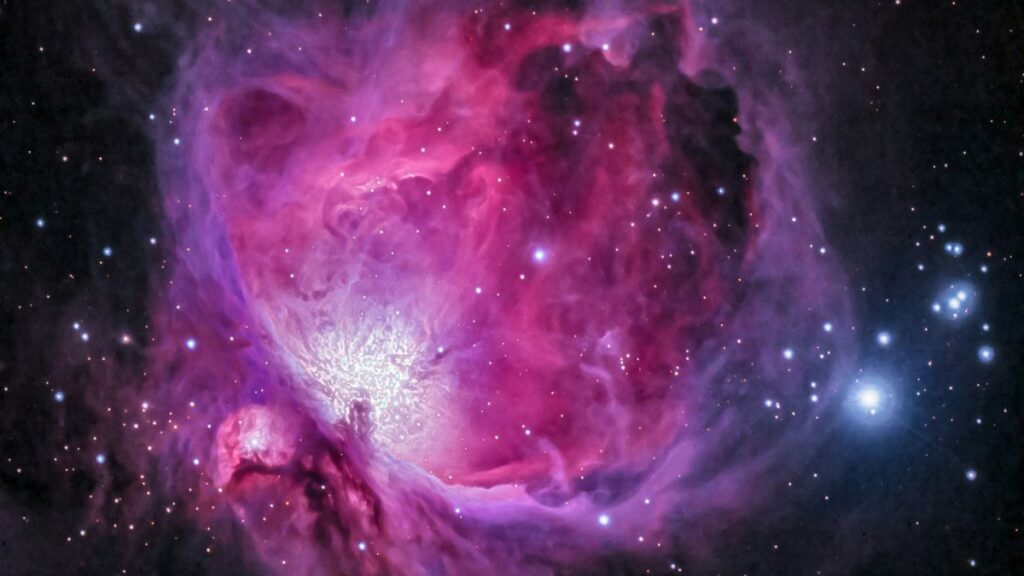
Understanding the origins of our universe is like diving into the ultimate mystery novel. It’s a tale that begins some 13.8 billion years ago when everything we know burst into existence in what we now call the Big Bang theory. The question of what exactly happened in those earliest moments is the kind of puzzle that keeps scientists and thinkers up at night. It’s not just about satisfying curiosity; it’s about unlocking the secrets of existence itself.
Search
Recent Posts:
- OpenAI Brings ChatGPT to be used in WhatsApp: Here’s How It Works and What You Can Do To Use It.
- Realme 14x 5G: A Budget Smartphone With Premium Features.
- Exploring Apple Genmoji: A New Era of Custom Emoji Creation.
- 2024 United States Presidential Election: Donald Trump Declares Victory in 2024 Presidential Election
- Chancellor Olaf Scholz’s Visit to India: Advancing Indo-German Cooperation on Defense, Trade, and Regional Stability.
David Spergel and the Simons Foundation Lead the Quest to Uncover the Universe’s Origins
One person who’s deeply invested in unraveling this cosmic enigma is David Spergel, the president of the Simons Foundation. Based in the heart of New York City, the Simons Foundation is all about supporting cutting-edge research in mathematics and science. For Spergel, the question of what went down at the dawn of the universe is nothing short of profound. “I think this question of what happens at the beginning of the universe is a profound one,” he says.
This excitement has manifested in the form of a groundbreaking new observatory nestled in the high desert of northern Chile. With a hefty price tag of $110 million, this state-of-the-art facility is poised to unlock some of the universe’s deepest secrets. And the Simons Foundation has played a significant role in bringing this ambitious project to life, contributing a substantial $90 million towards its construction.
Unraveling the Mysteries of Cosmic Inflation at the New Observatory
What exactly is this observatory looking for? Well, it’s all about clues—clues that could shed light on what happened in the immediate aftermath of the Big Bang. You see, there’s this mind-bending idea called cosmic inflation, which suggests that in the tiniest fraction of a second after the universe was born, space-time itself underwent a period of hyper-expansion. Imagine the universe blowing up like a balloon on steroids—that’s the kind of scale we’re talking about here.
The Cosmic inflation isn’t just some wild speculation—it’s a cornerstone of modern cosmology. But despite its theoretical elegance, it’s been very tricky to prove. That’s where the observatory comes in. By studying particles of light that have been traveling across the cosmos since the universe’s infancy, scientists hope to find evidence that could either confirm or define the cosmic inflation hypothesis once and for all.
It’s a high-stakes game, to be sure. If the observatory’s measurements line up with predictions made by cosmic inflation theory, it would provide compelling support for one of the most mind-bending ideas in all of science. But if the data tells a different story—if it contradicts the predictions of cosmic inflation—well, that would send shockwaves through the field of cosmology, forcing scientists to rethink some of their most fundamental assumptions about the nature of the universe.
The Simons Observatory: A Beacon of Human Curiosity and Ingenuity in the High Desert
Named after its benefactors, Jim and Marilyn Simons, the observatory is a testament to the power of human curiosity and ingenuity. Two of its four telescopes have already begun taking measurements, with the remaining two set to join them in the coming months. Placed on top of a desolate plateau some 17,000 feet above sea level, the observatory’s telescopes resemble something out of a science fiction movie.
But despite their otherworldly appearance, these telescopes are tasked with a decidedly down-to-earth mission: to gather microwaves—wavelengths of light that are longer than those we can see, but shorter than radio waves. It’s in these microwaves that scientists hope to find the clues they’re looking for—tiny fluctuations in temperature that could reveal crucial details about the early universe.
The Universe’s Fiery Beginnings and the Birth of Cosmic Microwave Background Radiation
For the first few hundred thousand years after the Big Bang, the universe was a pot of heat and energy. Temperatures were so high that even the simplest atoms, like hydrogen, couldn’t form. Instead, the universe was filled with a dense soup of charged particles and photons—particles of light—that constantly collided and interacted with one another.
But eventually, things began to cool down. As the universe expanded and temperatures dropped, the first atoms began to form, and the photons were finally free to travel through space unrestricted. Today, those ancient photons still linger in the cosmos, cooled to just a few degrees above absolute zero—a faint echo of the universe’s fiery birth.
It was the discovery of this cosmic microwave background radiation—a faint hiss of microwaves that fills the universe—that first hinted at the universe’s origins. But it wasn’t until the 1990s, with the launch of NASA’s Cosmic Background Explorer satellite, that scientists were able to unlock its full potential.
Uncovering the Hidden Ripples and Polarization in the Cosmic Microwave Background
What they found was nothing short of astonishing. Hidden within the seemingly uniform glow of the cosmic microwave background were tiny temperature variations—ripples in the fabric of space-time that hinted at the universe’s earliest moments. These fluctuations, caused by differences in the density of matter, would eventually give rise to the vast cosmic structures we see today—galaxies, clusters of galaxies, and beyond.
But while these temperature variations provided crucial insights into the universe’s evolution, they were just the beginning. Now, with the Simons Observatory, scientists are poised to delve even deeper into the mysteries of the cosmic microwave background—to explore not just its temperature, but its polarization as well.
Polarization, in this context, refers to the orientation of light waves as they travel through space. Normally, these waves oscillate in all directions, but when they interact with certain surfaces or particles, they can become aligned in a particular direction—a phenomenon known as polarization.
Unlocking the Secrets of the Universe’s Origins with the Simons Observatory’s Polarization Studies
At the Simons Observatory, scientists are using specialized detectors—essentially spinning polarizer filters—to study the polarization of cosmic microwaves. By measuring how the brightness of these microwaves changes as the filters spin, they can map out the patterns of polarization across the sky.
There are two main types of polarization patterns they’re interested in. The first, known as E-modes, are related to variations in the density of matter in the early universe. These E-modes have already been detected in previous observations of the cosmic microwave background, providing crucial clues about the universe’s structure and evolution.
But it’s the second type of polarization pattern—the elusive B-modes—that have scientists really excited. These B-modes are thought to be caused by gravitational waves—ripples in the fabric of space-time itself—that were generated in the earliest moments of the universe’s existence. If the Simons Observatory can detect these B-modes, it would provide hard evidence for cosmic inflation, confirming one of the most daring ideas in all of cosmology.
Detecting these B-modes won’t be easy. It requires incredibly sensitive instruments capable of picking up the faintest whispers of light from the farthest reaches of the cosmos. But if they succeed—if they manage to capture the faint signature of these primordial gravitational waves—it would be nothing short of revolutionary.
“It’s a unique instrument,” says Suzanne Staggs, a professor of physics at Princeton University and co-director of the Simons Observatory. “We just have so, so many detectors.”
The Quest Beyond Nobel Prizes
For Spergel and his colleagues, the stakes couldn’t be higher. The discovery of B-modes would not only confirm the cosmic inflation hypothesis, but it would also open up new avenues of exploration, providing unprecedented insights into the earliest moments of the universe’s existence.
“Detection, that will be a Nobel Prize,” says Gregory Gabadadze, a professor of physics at New York University and senior vice-president for physics at the Simons Foundation. “Never mind the Nobel Prize. The discovery of such a magnitude, who cares what prize you give it?” Indeed, for scientists like Spergel and Gabadadze, the true reward lies not in prizes, but in the sheer thrill of discovery—the exciting journey of unraveling the universe’s deepest secrets, one cosmic mystery at a time. And with the Simons Observatory leading the way, who knows what wonders they’ll uncover next?
To read more topics, please visit: https://insightfulbharat.com






